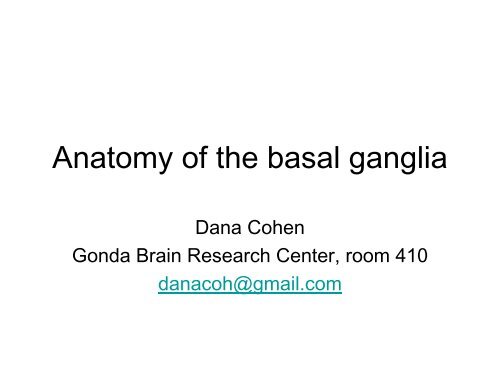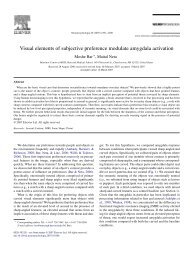1 Basal ganglia anatomy - Gonda Multidisciplinary Brain Research ...
1 Basal ganglia anatomy - Gonda Multidisciplinary Brain Research ...
1 Basal ganglia anatomy - Gonda Multidisciplinary Brain Research ...
You also want an ePaper? Increase the reach of your titles
YUMPU automatically turns print PDFs into web optimized ePapers that Google loves.
Anatomy of the basal <strong>ganglia</strong><br />
Dana Cohen<br />
<strong>Gonda</strong> <strong>Brain</strong> <strong>Research</strong> Center, room 410<br />
danacoh@gmail.com
A small number of neurons…<br />
• The basal <strong>ganglia</strong> receive projections from most cortical<br />
areas<br />
• The basal <strong>ganglia</strong> project out to cortical areas involved in<br />
the generation of behavior<br />
• Act in parallel with other output systems of the cortex<br />
and thus may not play a primary role in generating<br />
behavior<br />
• Essential for several types of learning
• Neocortex<br />
The cortico-basal <strong>ganglia</strong><br />
circuits consist of:<br />
• The striatum (caudate - putamen and the core of<br />
nucleus accumbens)<br />
• The globus pallidus (GP) (lateral and medial)<br />
• The subthalamic nucleus (STN)<br />
• Substantia nigra (SN) (pars compacta and pars<br />
reticulata) and the ventral tegmental area (VTA)
Anterior to posterior coronal view
Anterior to posterior coronal view
Anterior to posterior coronal view
Input and output of the basal <strong>ganglia</strong><br />
• Cortex to striatum: glutamate<br />
• MGP and SNr: GABA
The striatum<br />
• The major input nucleus of the BG.<br />
• Made up of the putamen, the caudate nucleus and<br />
nucleus accumbens which have similar histological and<br />
anatomical characteristics.<br />
• Receive input from most of the cortex (and the thalamus)<br />
• Complex bidirectional interaction with the substantia<br />
nigra pars compacta (SNc)<br />
• Output to both segments of the globus pallidus (GP) &<br />
the substantia nigra pars reticulata (SNr)
Striatum – Medium Spiny Neurons I<br />
• MSNs = Medium Spiny Neurons<br />
• > 90% of all cells in striatum<br />
• >10,000 cortical inputs to one MSN<br />
• GABAergic projection neurons<br />
• Dense collateral network<br />
• Two states:<br />
– ‘down’ state with low resting<br />
potential and no firing<br />
– ‘up’ state characterized by short<br />
firing episodes.
Striatum – Medium Spiny Neurons II<br />
• MSNs are typically quiet with no baseline firing.<br />
• Sensory and movement related response comprises of a<br />
short high frequency burst.<br />
• Highly specific to portion of the task and parts of the<br />
movement but can respond to several events.<br />
• Affected by sequence context or reward contingency.
The interneurons of the striatum make<br />
up about 5-10% of the neurons<br />
• TANs: large aspiny neurons – Ach (Was<br />
previously thought to be the projection neuron)
The GABAergic interneurons of the striatum<br />
• FSNs: medium aspiny neurons that contain parvalbumin<br />
• Medium aspiny neurons that contain somatostatin
The medial globus pallidus and the SNr<br />
• Primarily made up of<br />
GABAergic projection neurons.<br />
• Firing rate at rest is 60-100<br />
spikes/s and is highly irregular<br />
(The ultimate Poissonian<br />
neuron).<br />
• Sensory and motor response is<br />
broad and includes increases<br />
and decreases of firing rate.
The lateral globus pallidus (GPe)<br />
• Same morphology as the MGP<br />
• High frequency pausers (HFP) & lowfrequency<br />
bursters (LFB)<br />
• Internal to the basal <strong>ganglia</strong> with no<br />
external connections for input or output
The subthalamic nucleus<br />
• Made up mainly of projection<br />
neurons. Firing rate at rest is 20-<br />
30 spikes/s with short burst<br />
following movement.<br />
• The projection neurons are<br />
glutamatergic and send their<br />
output to the GPi & SNr.<br />
• In addition to its role in the indirect<br />
pathway, has direct cortical inputs<br />
forming the hyperdirect pathway.
Direct and indirect pathways<br />
• The direct pathway causes disinhibition<br />
• The indirect pathway is more complex but likely to<br />
counterbalance the direct pathway
Feedback pathways
Cortical input to the striatum<br />
originates from most cortical areas<br />
• Primary and higher order sensory areas, motor,<br />
premotor, and prefrontal regions, and limbic cortical<br />
areas.<br />
• The input is organized topographically<br />
– Frontal areas project to rostral striatum<br />
– Sensorimotor cortex projects to dorsolateral striatum<br />
– Parietal cortex projects to caudal striatum<br />
– Highly interconnected cortices may overlap in the striatum<br />
• Numbers:<br />
– There are 17 million cortico-striatal cells<br />
– There are almost 2.8 million striatal projection neurons<br />
– No 2 striatal neurons share their cortical input
Synaptic input to distal dendrites of<br />
the MSNs
Inputs to the proximal and distal<br />
dendrites of the MSNs
Direct and indirect striatal projection neurons<br />
selectively express the D1 and D2 receptors
Components of the indirect pathway
Synaptic inputs to the SNr<br />
• The SNc and SNr<br />
cannot be distinguished<br />
based on the<br />
morphological<br />
properties of the<br />
neurons<br />
– Dopaminergic neurons<br />
– GABAergic neurons





